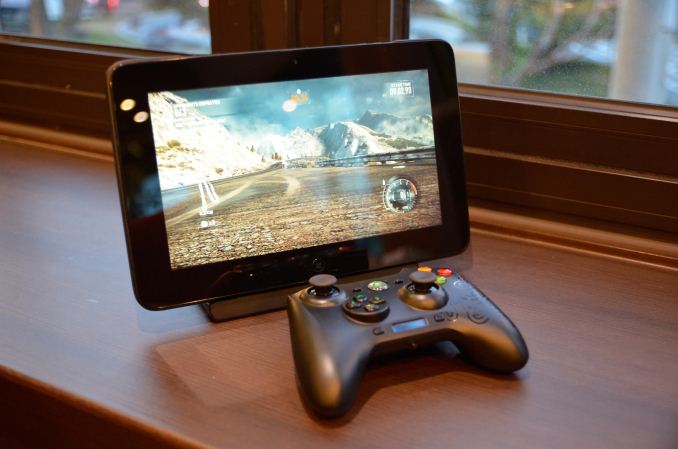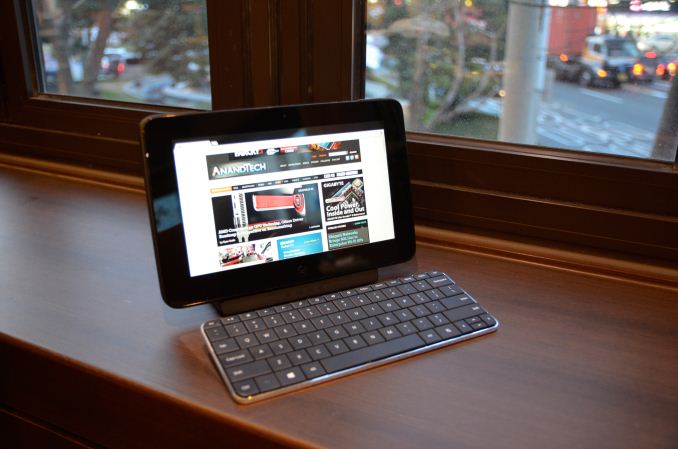The Razer Edge Review
by Vivek Gowri on March 28, 2013 11:00 AM EST- Posted in
- Tablets
- Mobile
- Razer
- Razer Edge
Dock and Keyboard
The docking station is pretty simple, just a wedge-shaped plastic part with a rubberized base that features a dock connector and two pins to hold the Edge in place. The back has a power connector, separate 3.5mm jacks for line in and audio out, an HDMI port, and three USB 2.0 ports. It’s worth stating this again, but the dock is actually the *only* way to get video out from the tablet. The lack of USB 3.0 ports is related to a bandwidth limitation for the dock connector and not a case of Razer being cheap with their port selection, though I’d still have liked to see at least one of the three ports be USB 3.0.
There are two primary use cases for the dock that I can see it serving pretty well – hooked up to a TV and Xbox controllers in what Razer calls “console mode”, as well as at a desk with an external monitor, keyboard, and mouse. Razer had a number of Edges set up as consoles at CES both in their booth as well as in their meeting room suite – they also announced the Sabertooth controller for Xbox 360 at CES, so it made for a nice two-in-one product showcase. It worked pretty well, though it’s worth mentioning that the displays were mirrored at 1366x768. This goes back to GT 640M LE being not suited at all to gaming at resolutions above that – running new games at 1080p on anything lower than a GT 650M can be a bit painful. But if you’re willing to play at the native resolution of the tablet and not the native res of the TV, it’s a pretty enjoyable way to game. I spent an evening with some of Razer’s marketing guys playing Dirt Showdown on a docked Edge hooked up to a 60” TV and a few Sabertooths, and the Edge acquitted itself well in this type of situation. If you just leave the dock hooked up to the TV and controllers, it’s really easy to just drop the tablet into it when you want to play.
The desktop use case is the other one where the dock is ideally suited. Connected to an external display and a Bluetooth keyboard and mouse, it makes for a decent setup. This is one of the few tablets powerful enough that I could use it as a main day to day work machine, especially in the i7/8GB/256GB configuration I have here. Now, I’m not going to give up the M18x I’m currently using at my desk, but if you had to use a tablet as your primary machine, wouldn’t the Edge be very close to the top of your list?
The only remaining piece of the puzzle is the keyboard dock, which we saw displayed in very early preproduction form at CES. Back in January, it was a really rough build – the keyboard was tiny, there was tons of flex, the hinge was questionable, and the mechanism to keep it closed was a very high tech elastic band. Rough is probably understating it. I know that Min was using one during the show, but it looked like the primary intent of those hand-built preproduction units was to have the keyboard dock on display and not necessarily in a usable form. The final keyboard dock is slated for Q3, and will likely look pretty similar to the one shown previously (though with a substantially different latching mechanism). I feel like the keys will need to be bigger for the keyboard to be comfortable, and there’s enough number of perfectly good tablet-size keyboards out there for Razer to look at. I’d like to highlight, in particular, the Surface Type Cover and any ASUS 10.1” keyboard since, say, 2008, as good examples. Borrow liberally from those designs and it’ll be great.
In absence of the keyboard, I’ve turned to Microsoft’s Wedge mobile Bluetooth keyboard and paired it with the HDMI docking station to come up with a workable temporary solution for portable typing. When it arrives, the keyboard dock will be compatible with the extended 41.44Wh battery that works with the gamepad controller, offering a potential 10 hours of usable battery life in netbook mode. Given the pricing of the accessories we’ve seen thus far, I’d expect the dock to come in at no less than the $129-149 price range.













89 Comments
View All Comments
A5 - Thursday, March 28, 2013 - link
It seems like the 2nd generation of this will be way better, if what half of Intel is saying about Haswell and GT3e is true.VivekGowri - Thursday, March 28, 2013 - link
That's something I wanted to touch on in the conclusion but ran out of time/forgot: GT3e will make the second generation of this really, really interesting. Haswell/GT3e is going to be an awesome combination, but like Anand tweeted, it'll be a while (14nm in 2015) until we get a real best of both worlds solution.A5 - Thursday, March 28, 2013 - link
Yeah, it seems that way. Thanks for the reply.tech.noob.fella - Friday, March 29, 2013 - link
isnt gt3 only for desktops?? i thought gt2 was for portables like this machine...not sure thoughKristian Vättö - Friday, March 29, 2013 - link
GT3 is for laptops too (and even the GT3e). Intel has always focused the best IGPs to mobile CPUs because those systems are the most likely to only feature integrated graphics. Desktops often have a dGPU because there's no heat/space/battery issue, especially if the system is geared towards something graphics intensive (IGPs, even lower-end ones, are fine for basic use).TerdFerguson - Thursday, March 28, 2013 - link
I find this review to be overly generous. Hardware should be reviewed on its merits, not on whether or not you approve of the concept. Asking nearly $2k for this monstrosity is utterly unreasonable.VivekGowri - Thursday, March 28, 2013 - link
It starts at $999, and the most reasonable configuration is $1499 - this honestly isn't that much more than Surface Pro or any of the other high-end Windows 8 tablets. I'd much, much rather pay $1499 for Edge Pro + gamepad than $1199 for the ATIV Smart PC Pro + laptop dock. Surface Pro plus Type Cover for $1139 is probably an equally decent value, but significantly slower (i5/HD4000/4GB vs i7/GT640MLE/8GB) and plays in a completely different market.andrewaggb - Thursday, March 28, 2013 - link
The docks are still the killers for me. At a desk I want to run 2 monitors at 1080p each minimum, preferrably with both 1920x1200 or better. And a usb keyboard and mouse. I could have a dock setup like that at the work office and home office and just drop the tablet in wherever I'm at. Wouldn't care if the tablet screen was disabled when docked running 2 external displays.I would also like a transformer style keyboard dock so I could use it as a laptop.
When I can do all that, with an i7/8gb/256gb+ ssd, it will be sweet. It sucks because I'm sure it could be done now and nobody seems to have done it. Hopefully with haswell... but everybody keeps talking about haswell like it's the second coming, I'm worried it's not going to live up to our expectations.
zanon - Thursday, March 28, 2013 - link
Vivek mentioned Tb, and what you describe is one of the few areas where it'd be really interesting. The dock could itself have a standard graphics card, and thus drive multiple large screens and more powerful gaming while still allowing the tablet part to get away with much less graphics power.15th Warlock - Thursday, March 28, 2013 - link
I have to agree with Terd, while $999 may be the prize of entrance for the Edge experience, the review doesn't actually test the default battery configuration (regardless of it being the pro or non pro version).What this review shows us is a best scenario, using the $250 gamepad attachment and $70 extra battery, that's $320 over the original MSRP, so, even in this scenario you only get 2 hrs of gaming when not plugged to the wall.
The review fails to mention that out of the box this tablet offers only one hour of gaming, and perhaps, less than 3 hrs. of regular use, if razer offered the extra battery with the gamepad attachment it would be a more tolerable proposal, but nickel and diming gamers for the privilege to play for two hrs is way too much, not even Apple limits the user experience in such a way with their overpriced toys...